Eco FIAT TALENTO 2020 Owner handbook (in English)
[x] Cancel search | Manufacturer: FIAT, Model Year: 2020, Model line: TALENTO, Model: FIAT TALENTO 2020Pages: 236, PDF Size: 4.86 MB
Page 158 of 236
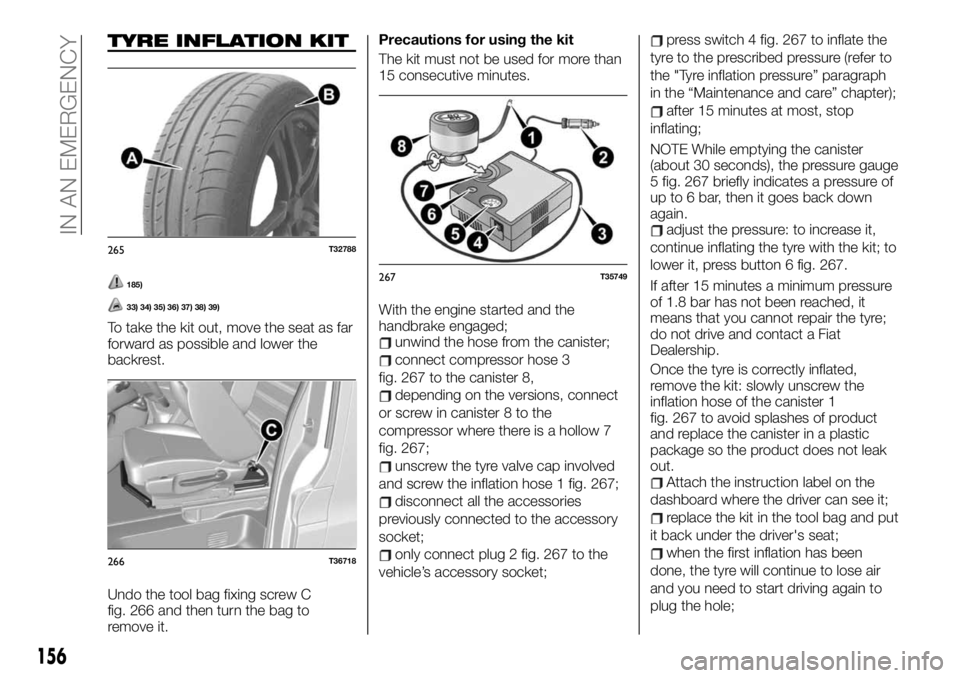
TYRE INFLATION KIT
185)
33) 34) 35) 36) 37) 38) 39)
To take the kit out, move the seat as far
forward as possible and lower the
backrest.
Undo the tool bag fixing screw C
fig. 266 and then turn the bag to
remove it.Precautions for using the kit
The kit must not be used for more than
15 consecutive minutes.
With the engine started and the
handbrake engaged;unwind the hose from the canister;
connect compressor hose 3
fig. 267 to the canister 8,
depending on the versions, connect
or screw in canister 8 to the
compressor where there is a hollow 7
fig. 267;
unscrew the tyre valve cap involved
and screw the inflation hose 1 fig. 267;
disconnect all the accessories
previously connected to the accessory
socket;
only connect plug 2 fig. 267 to the
vehicle’s accessory socket;
press switch 4 fig. 267 to inflate the
tyre to the prescribed pressure (refer to
the "Tyre inflation pressure” paragraph
in the “Maintenance and care” chapter);
after 15 minutes at most, stop
inflating;
NOTE While emptying the canister
(about 30 seconds), the pressure gauge
5 fig. 267 briefly indicates a pressure of
up to 6 bar, then it goes back down
again.
adjust the pressure: to increase it,
continue inflating the tyre with the kit; to
lower it, press button 6 fig. 267.
If after 15 minutes a minimum pressure
of 1.8 bar has not been reached, it
means that you cannot repair the tyre;
do not drive and contact a Fiat
Dealership.
Once the tyre is correctly inflated,
remove the kit: slowly unscrew the
inflation hose of the canister 1
fig. 267 to avoid splashes of product
and replace the canister in a plastic
package so the product does not leak
out.
Attach the instruction label on the
dashboard where the driver can see it;
replace the kit in the tool bag and put
it back under the driver's seat;
when the first inflation has been
done, the tyre will continue to lose air
and you need to start driving again to
plug the hole;
265T32788
266T36718
267T35749
156
IN AN EMERGENCY
Page 161 of 236
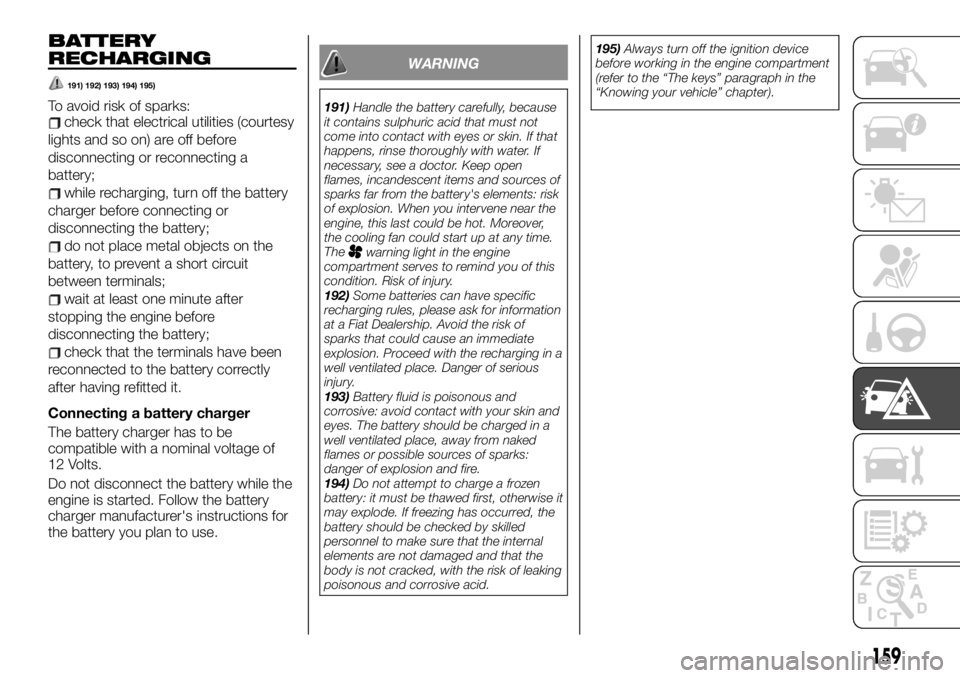
BATTERY
RECHARGING
191) 192) 193) 194) 195)
To avoid risk of sparks:check that electrical utilities (courtesy
lights and so on) are off before
disconnecting or reconnecting a
battery;
while recharging, turn off the battery
charger before connecting or
disconnecting the battery;
do not place metal objects on the
battery, to prevent a short circuit
between terminals;
wait at least one minute after
stopping the engine before
disconnecting the battery;
check that the terminals have been
reconnected to the battery correctly
after having refitted it.
Connecting a battery charger
The battery charger has to be
compatible with a nominal voltage of
12 Volts.
Do not disconnect the battery while the
engine is started. Follow the battery
charger manufacturer's instructions for
the battery you plan to use.
WARNING
191)Handle the battery carefully, because
it contains sulphuric acid that must not
come into contact with eyes or skin. If that
happens, rinse thoroughly with water. If
necessary, see a doctor. Keep open
flames, incandescent items and sources of
sparks far from the battery's elements: risk
of explosion. When you intervene near the
engine, this last could be hot. Moreover,
the cooling fan could start up at any time.
The
warning light in the engine
compartment serves to remind you of this
condition. Risk of injury.
192)Some batteries can have specific
recharging rules, please ask for information
at a Fiat Dealership. Avoid the risk of
sparks that could cause an immediate
explosion. Proceed with the recharging in a
well ventilated place. Danger of serious
injury.
193)Battery fluid is poisonous and
corrosive: avoid contact with your skin and
eyes. The battery should be charged in a
well ventilated place, away from naked
flames or possible sources of sparks:
danger of explosion and fire.
194)Do not attempt to charge a frozen
battery: it must be thawed first, otherwise it
may explode. If freezing has occurred, the
battery should be checked by skilled
personnel to make sure that the internal
elements are not damaged and that the
body is not cracked, with the risk of leaking
poisonous and corrosive acid.195)Always turn off the ignition device
before working in the engine compartment
(refer to the “The keys” paragraph in the
“Knowing your vehicle” chapter).
159
Page 167 of 236
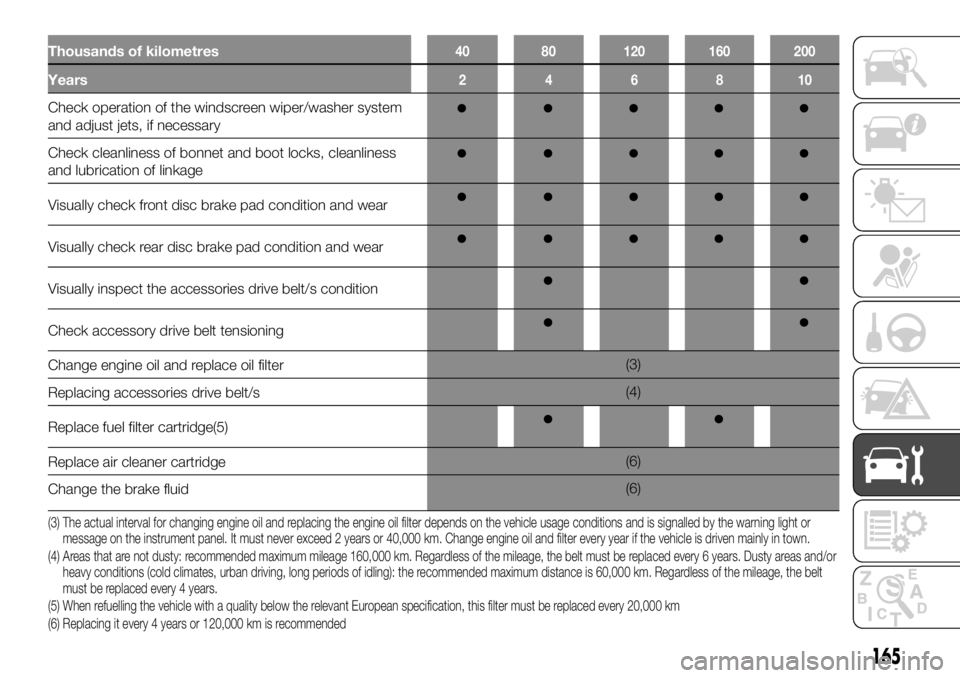
Thousands of kilometres40 80 120 160 200
Years246810
Check operation of the windscreen wiper/washer system
and adjust jets, if necessary
Check cleanliness of bonnet and boot locks, cleanliness
and lubrication of linkage
Visually check front disc brake pad condition and wear
Visually check rear disc brake pad condition and wear
Visually inspect the accessories drive belt/s condition
Check accessory drive belt tensioning
Change engine oil and replace oil filter(3)
Replacing accessories drive belt/s(4)
Replace fuel filter cartridge(5)
Replace air cleaner cartridge(6)
Change the brake fluid(6)
(3) The actual interval for changing engine oil and replacing the engine oil filter depends on the vehicle usage conditions and is signalled by the warning light or
message on the instrument panel. It must never exceed 2 years or 40,000 km. Change engine oil and filter every year if the vehicle is driven mainly in town.
(4) Areas that are not dusty: recommended maximum mileage 160,000 km. Regardless of the mileage, the belt must be replaced every 6 years. Dusty areas and/or
heavy conditions (cold climates, urban driving, long periods of idling): the recommended maximum distance is 60,000 km. Regardless of the mileage, the belt
must be replaced every 4 years.
(5) When refuelling the vehicle with a quality below the relevant European specification, this filter must be replaced every 20,000 km
(6) Replacing it every 4 years or 120,000 km is recommended
165
Page 168 of 236
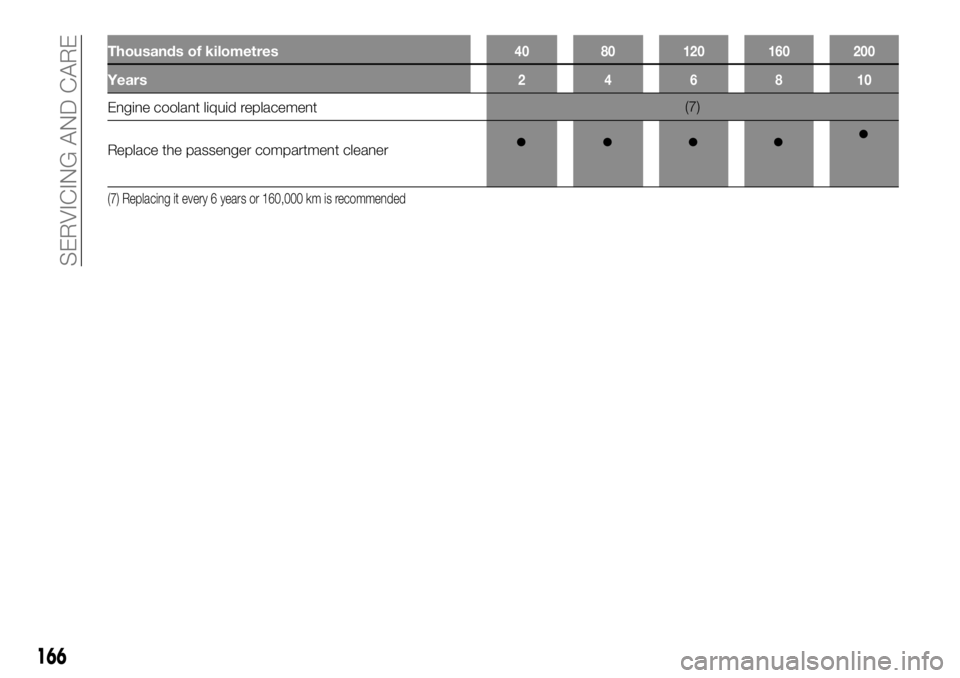
Thousands of kilometres40 80 120 160 200
Years246810
Engine coolant liquid replacement(7)
Replace the passenger compartment cleaner
(7) Replacing it every 6 years or 160,000 km is recommended
166
SERVICING AND CARE
Page 170 of 236
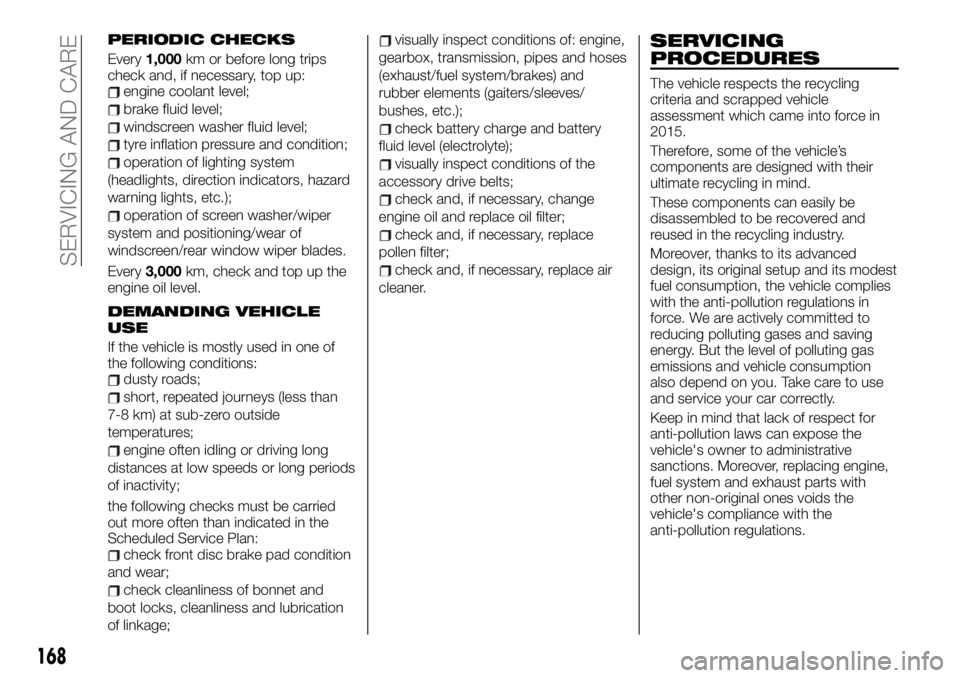
PERIODIC CHECKS
Every1,000km or before long trips
check and, if necessary, top up:
engine coolant level;
brake fluid level;
windscreen washer fluid level;
tyre inflation pressure and condition;
operation of lighting system
(headlights, direction indicators, hazard
warning lights, etc.);
operation of screen washer/wiper
system and positioning/wear of
windscreen/rear window wiper blades.
Every3,000km, check and top up the
engine oil level.
DEMANDING VEHICLE
USE
If the vehicle is mostly used in one of
the following conditions:
dusty roads;
short, repeated journeys (less than
7-8 km) at sub-zero outside
temperatures;
engine often idling or driving long
distances at low speeds or long periods
of inactivity;
the following checks must be carried
out more often than indicated in the
Scheduled Service Plan:
check front disc brake pad condition
and wear;
check cleanliness of bonnet and
boot locks, cleanliness and lubrication
of linkage;
visually inspect conditions of: engine,
gearbox, transmission, pipes and hoses
(exhaust/fuel system/brakes) and
rubber elements (gaiters/sleeves/
bushes, etc.);
check battery charge and battery
fluid level (electrolyte);
visually inspect conditions of the
accessory drive belts;
check and, if necessary, change
engine oil and replace oil filter;
check and, if necessary, replace
pollen filter;
check and, if necessary, replace air
cleaner.
SERVICING
PROCEDURES
The vehicle respects the recycling
criteria and scrapped vehicle
assessment which came into force in
2015.
Therefore, some of the vehicle’s
components are designed with their
ultimate recycling in mind.
These components can easily be
disassembled to be recovered and
reused in the recycling industry.
Moreover, thanks to its advanced
design, its original setup and its modest
fuel consumption, the vehicle complies
with the anti-pollution regulations in
force. We are actively committed to
reducing polluting gases and saving
energy. But the level of polluting gas
emissions and vehicle consumption
also depend on you. Take care to use
and service your car correctly.
Keep in mind that lack of respect for
anti-pollution laws can expose the
vehicle's owner to administrative
sanctions. Moreover, replacing engine,
fuel system and exhaust parts with
other non-original ones voids the
vehicle's compliance with the
anti-pollution regulations.
168
SERVICING AND CARE
Page 172 of 236

Unscrew cap 1 fig. 274;
restore the level (the approximate
amount to get between the dipstick 2
"min" and "max" levels is about 1.5 and
2 litres, depending on the engine);
wait about 10 seconds to let the oil
flow in the circuit;
check the level with the dipstick 2
fig. 274 (as described above).
Once the operation is done, insert the
dipstick as far as it will go or screw the
cap back on completely.
IMPORTANT To avoid splashing, use a
funnel when topping up/filling up.
IMPORTANT Never exceed the "max"
level and do not forget to put the cap
1 back on and dipstick 2 fig. 274 in
place.
201) 199) 200) 202) 203) 204) 205) 206) 207) 208)
Change engine oil
Contact a Fiat Dealership.Amount of oil to replace
Always check the oil level with the
dipstick (it must never be below the
MIN level nor above the MAX level).
Engine oil quality
Refer to the “Fluids and lubricants”
paragraph on the “Technical data”
chapter.
IMPORTANT In case of unusual,
repeated drop, see a Fiat Dealership.
BRAKE FLUID
The level is checked with the engine
stopped and on a horizontal surface.
It has to be checked often and in any
case every time there is a minimum
variation in the braking system.Level 2 fig. 275
Normally the level drops along with the
brake pad wear, but it should not drop
below the warning threshold "MIN".
212) 213)
45) 49)
Filling
Every operation on the hydraulic circuit
involves replacing the fluid by a
specialised technician.
Use an approved fluid only (taken from
a new pack).
Replacement
Refer to the Scheduled Service Plan (in
this chapter).
IMPORTANT In case of unusual,
repeated drop, see a Fiat Dealership.
COOLANT LIQUID
With the engine off, on a level surface,
the cold level should be between "MIN"
and "MAX" indicated on coolant tank 1
fig. 276.
IMPORTANT In case of unusual,
repeated drop, see a Fiat Dealership.
274T36610
275T36609
170
SERVICING AND CARE
Page 176 of 236
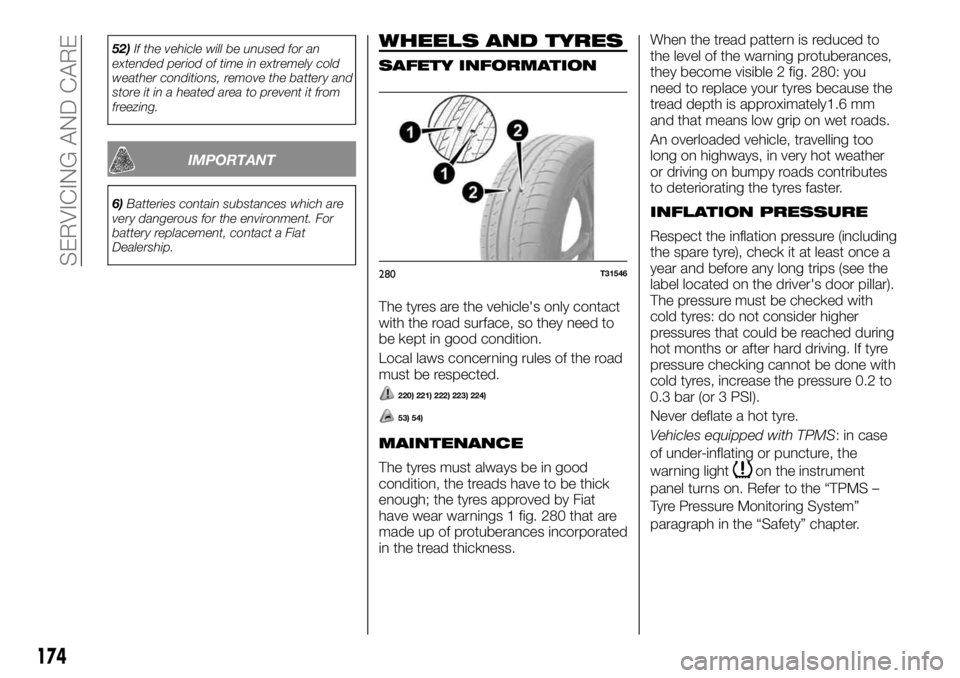
52)If the vehicle will be unused for an
extended period of time in extremely cold
weather conditions, remove the battery and
store it in a heated area to prevent it from
freezing.
IMPORTANT
6)Batteries contain substances which are
very dangerous for the environment. For
battery replacement, contact a Fiat
Dealership.
WHEELS AND TYRES
SAFETY INFORMATION
The tyres are the vehicle's only contact
with the road surface, so they need to
be kept in good condition.
Local laws concerning rules of the road
must be respected.
220) 221) 222) 223) 224)
53) 54)
MAINTENANCE
The tyres must always be in good
condition, the treads have to be thick
enough; the tyres approved by Fiat
have wear warnings 1 fig. 280 that are
made up of protuberances incorporated
in the tread thickness.When the tread pattern is reduced to
the level of the warning protuberances,
they become visible 2 fig. 280: you
need to replace your tyres because the
tread depth is approximately1.6 mm
and that means low grip on wet roads.
An overloaded vehicle, travelling too
long on highways, in very hot weather
or driving on bumpy roads contributes
to deteriorating the tyres faster.
INFLATION PRESSURE
Respect the inflation pressure (including
the spare tyre), check it at least once a
year and before any long trips (see the
label located on the driver's door pillar).
The pressure must be checked with
cold tyres: do not consider higher
pressures that could be reached during
hot months or after hard driving. If tyre
pressure checking cannot be done with
cold tyres, increase the pressure 0.2 to
0.3 bar (or 3 PSI).
Never deflate a hot tyre.
Vehicles equipped with TPMS: in case
of under-inflating or puncture, the
warning light
on the instrument
panel turns on. Refer to the “TPMS –
Tyre Pressure Monitoring System”
paragraph in the “Safety” chapter.
280T31546
174
SERVICING AND CARE
Page 178 of 236
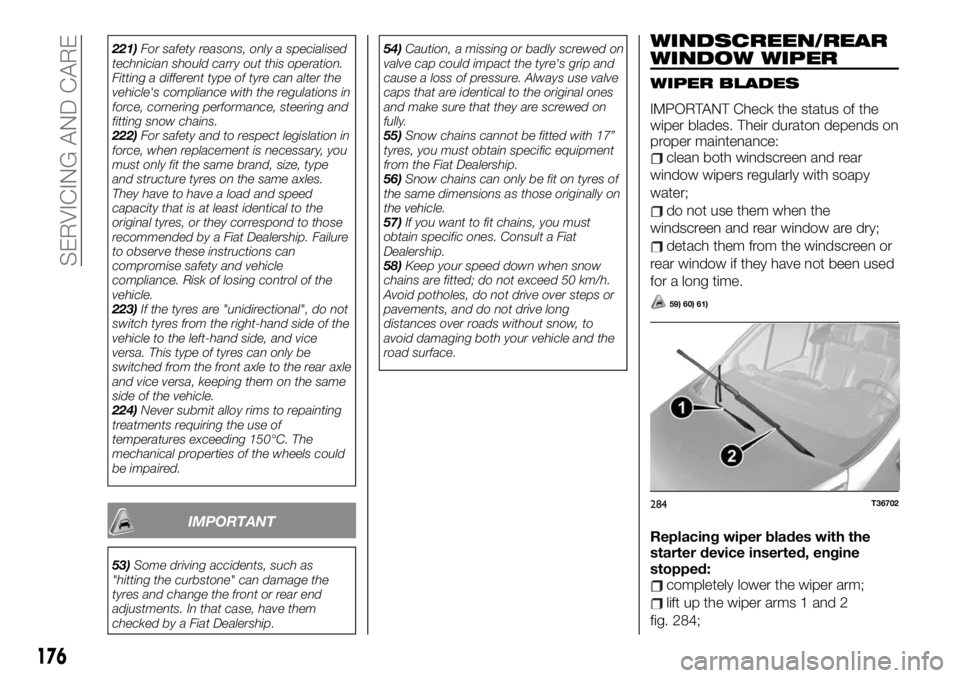
221)For safety reasons, only a specialised
technician should carry out this operation.
Fitting a different type of tyre can alter the
vehicle's compliance with the regulations in
force, cornering performance, steering and
fitting snow chains.
222)For safety and to respect legislation in
force, when replacement is necessary, you
must only fit the same brand, size, type
and structure tyres on the same axles.
They have to have a load and speed
capacity that is at least identical to the
original tyres, or they correspond to those
recommended by a Fiat Dealership. Failure
to observe these instructions can
compromise safety and vehicle
compliance. Risk of losing control of the
vehicle.
223)If the tyres are "unidirectional", do not
switch tyres from the right-hand side of the
vehicle to the left-hand side, and vice
versa. This type of tyres can only be
switched from the front axle to the rear axle
and vice versa, keeping them on the same
side of the vehicle.
224)Never submit alloy rims to repainting
treatments requiring the use of
temperatures exceeding 150°C. The
mechanical properties of the wheels could
be impaired.
IMPORTANT
53)Some driving accidents, such as
"hitting the curbstone" can damage the
tyres and change the front or rear end
adjustments. In that case, have them
checked by a Fiat Dealership.54)Caution, a missing or badly screwed on
valve cap could impact the tyre's grip and
cause a loss of pressure. Always use valve
caps that are identical to the original ones
and make sure that they are screwed on
fully.
55)Snow chains cannot be fitted with 17”
tyres, you must obtain specific equipment
from the Fiat Dealership.
56)Snow chains can only be fit on tyres of
the same dimensions as those originally on
the vehicle.
57)If you want to fit chains, you must
obtain specific ones. Consult a Fiat
Dealership.
58)Keep your speed down when snow
chains are fitted; do not exceed 50 km/h.
Avoid potholes, do not drive over steps or
pavements, and do not drive long
distances over roads without snow, to
avoid damaging both your vehicle and the
road surface.
WINDSCREEN/REAR
WINDOW WIPER
WIPER BLADES
IMPORTANT Check the status of the
wiper blades. Their duraton depends on
proper maintenance:
clean both windscreen and rear
window wipers regularly with soapy
water;
do not use them when the
windscreen and rear window are dry;
detach them from the windscreen or
rear window if they have not been used
for a long time.
59) 60) 61)
Replacing wiper blades with the
starter device inserted, engine
stopped:
completely lower the wiper arm;
lift up the wiper arms 1 and 2
fig. 284;
284T36702
176
SERVICING AND CARE
Page 186 of 236
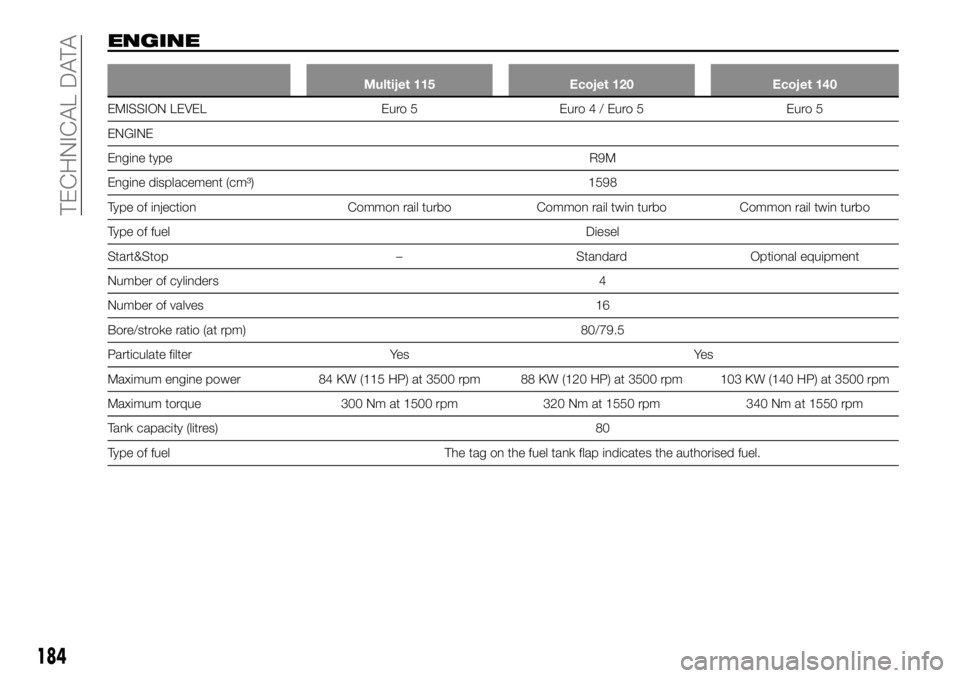
ENGINE
Multijet 115 Ecojet 120 Ecojet 140
EMISSION LEVEL Euro 5 Euro4/Eur
o5 Euro5
ENGINE
Engine typeR9M
Engine displacement (cm³) 1598
Type of injection Common rail turbo Common rail twin turbo Common rail twin turbo
Type of fuelDiesel
Start&Stop – Standard Optional equipment
Number of cylinders 4
Number of valves 16
Bore/stroke ratio (at rpm) 80/79.5
Particulate filter Yes Yes
Maximum engine power 84 KW (115 HP) at 3500 rpm 88 KW (120 HP) at 3500 rpm 103 KW (140 HP) at 3500 rpm
Maximum torque 300 Nm at 1500 rpm 320 Nm at 1550 rpm 340 Nm at 1550 rpm
Tank capacity (litres) 80
Type of fuel The tag on the fuel tank flap indicates the authorised fuel.
184
TECHNICAL DATA
Page 187 of 236
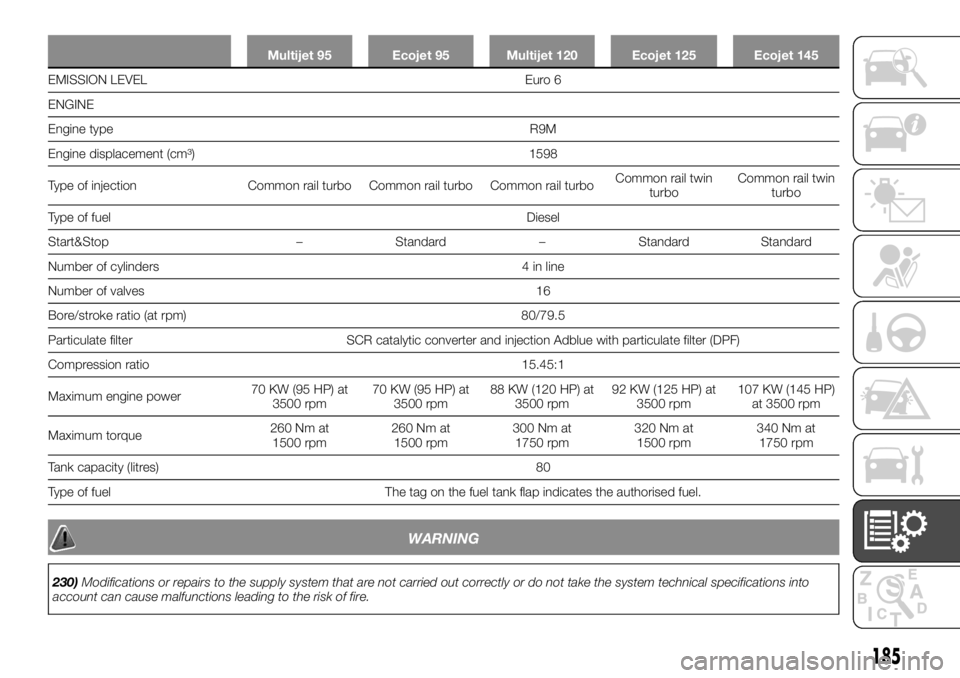
Multijet 95 Ecojet 95 Multijet 120 Ecojet 125 Ecojet 145
EMISSION LEVEL Euro 6
ENGINE
Engine
typeR9M
Engine displacement
(cm³) 1598
Type of injection Common rail turbo Common rail turbo Common rail turboCommon rail twin
turboCommon rail twin
turbo
Type of fuelDiesel
Start&Stop – Standard – Standard Standard
Number of cylinders 4 in line
Number of valves 16
Bore/stroke ratio (at rpm) 80/79.5
Particulate filter SCR catalytic converter and injection Adblue with particulate filter (DPF)
Compression ratio 15.45:1
Maximum engine power70 KW (95 HP) at
3500 rpm70 KW (95 HP) at
3500 rpm88 KW (120 HP) at
3500 rpm92 KW (125 HP) at
3500 rpm107 KW (145 HP)
at 3500 rpm
Maximum torque260 Nm at
1500 rpm260 Nm at
1500 rpm300 Nm at
1750 rpm320 Nm at
1500 rpm340 Nm at
1750 rpm
Tank capacity (litres) 80
Type of fuel The tag on the fuel tank flap indicates the authorised fuel.
WARNING
230)Modifications or repairs to the supply system that are not carried out correctly or do not take the system technical specifications into
account can cause malfunctions leading to the risk of fire.
185